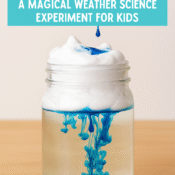
Spinning Science: How to Make Tornado Tubes
How to Turn It into Learning?
From swirling storm clouds to dramatic news reports, tornadoes capture children’s imaginations. But fear can quickly turn into fascination when we bring science down to their level. Instead of only telling kids about vortexes and cyclones, what if we let them build one with their own hands?
Tornado Tubes offer a safe, visually striking, and educationally rich way to teach children about:
- The science of air pressure and vortex formation
- Observation and cause-effect relationships
- Weather safety and the power of natural phenomena
This hands-on activity is more than just spinning water in a bottle—it’s a gateway to curiosity, critical thinking, and wow-filled learning moments.
What Are Tornado Tubes?
A tornado tube is a simple science tool that connects two plastic bottles together. When filled with water and spun in a particular way, the water drains from the top bottle to the bottom in a swirling vortex—just like a tornado.
They’re often used in classrooms and STEM workshops because they:
- Require very little setup
- Are inexpensive to make
- Offer clear visual feedback
- Can be reused over and over
The Science Behind the Spin
Before we build one, let’s explore what’s actually happening when you make a tornado tube:
What is a Vortex?
A vortex is a spinning, spiral movement of fluid (in this case, water and air). Tornadoes, whirlpools, and even draining sinks all create vortexes.
In a tornado tube, the vortex forms because:
- Gravity pulls the water down
- Air pressure pushes from below
- The swirling motion helps organise the movement, creating a stable, visible spiral
Without spinning, water just glugs down randomly due to uneven air and water exchange. Spinning forms a hollow tunnel through the centre (the “eye” of the vortex), making the water drain faster and smoother—just like a real tornado.
Materials You’ll Need
For a single tornado tube:
- 2 clear plastic bottles (1-litre or 2-litre soda bottles work best)
- 1 tornado tube connector (buy online or use duct tape)
- Water
- Glitter, food colouring, or dish soap (optional for visual effect)
- Stopwatch (optional for challenges)
- Printed experiment worksheet (see free download below)
Tip: Tornado tube connectors can be reused for years of classroom fun, or easily made with tape and patience.
Step-by-Step: How to Make Your Own Tornado Tube
Step 1: Clean and Fill
Wash your bottles thoroughly. Fill one bottle about two-thirds full of water. Add a few drops of food colouring, a spoon of glitter, or a squeeze of dish soap for a dramatic effect.
STEM Challenge: Ask kids to predict what will happen when you shake the bottle instead of spin it.
Step 2: Connect the Bottles
Use a tornado tube connector or strong duct tape to seal the mouths of both bottles together—one upside down over the other. Make sure the seal is tight to prevent leaks.
Hold it upright so the full bottle is on top, and the empty bottle is on the bottom.
Step 3: Flip & Spin
Quickly flip the whole structure upside down, then swirl the bottles in a circular motion.
Within seconds, you’ll see a whirlpool forming as water spins into the bottom bottle. This spinning motion helps displace air and forms a vortex.
Tip: Try swirling clockwise vs. counterclockwise. Does it change the vortex?
Step 4: Observe & Record
Use a timer to see how long it takes the water to drain with and without swirling. Use the observation sheet (linked below) to draw what the vortex looks like and write down what you notice.
Encourage children to describe the shape, motion, and sound of the tornado.

Make It Bigger: Tornado Tube Extensions
Once children get the basic version working, here are ways to take it further:
1. Test With Different Liquids
Try oil, coloured syrup, or even soapy water. What spins faster or slower? Which makes the clearest vortex?
2. Add Floating Objects
Drop in small beads or foil stars and watch them spiral down. This adds a visual tracking layer.
3. Vortex Race
Let each child or group time how long their vortex takes to drain. Who can design the fastest tornado tube?
4. Compare With Real Tornado Stats
Show images or videos of real tornadoes. Discuss how vortex shape, rotation direction, and intensity vary in nature.
Discussion Questions to Deepen Learning
- What happens if we don’t spin the bottles?
- Why does the vortex form in the middle?
- Can we see tornadoes in nature behave like this?
- What does gravity do in this experiment?
- How do tornado tubes help us learn about air pressure?
Encouraging kids to talk about what they see builds scientific vocabulary and comprehension.
Downloadable Resource Pack
To help you get the most out of this activity, we’ve created a free printable PDF that includes:
Tornado Tube Observation Sheet
Drawing Space for Vortex Shape
Predict/Observe/Reflect prompts
Classroom Extension Activity Ideas
Editable Parent-Teacher License
Click here to download the Tornado Tube Experiment Kit
(Also available on our Free Resources page under “Weather Science”)
Quick Variant for Younger Kids
No bottles? No problem. Try this simpler version:
- Fill a clear bowl with water
- Add a few drops of dish soap and glitter
- Stir quickly with a spoon in one direction
- Watch the water spiral in a mini bowl-sized vortex!
This is ideal for preschoolers who benefit from visual and tactile experiences.
What Parents & Teachers Say
“Tornado tubes are one of the easiest science setups I’ve used in my class—and the kids loved it. We turned it into a race and even graphed the results.”
— Ms. Tash, Year 4 Science Teacher
“My daughter kept flipping her tornado tube for 45 minutes. She started asking about storms and clouds. It sparked so much curiosity.”
— Brian K., Parent
Related Activities to Explore Next
- Pinwheel Science for Focus & Calm
- Floating and Sinking: Water STEM Exploration
- Mindful Breathing Crafts for Calm Classrooms
Final Thoughts
Tornado tubes are more than a cool water trick. They’re a way to:
- Empower kids to create and experiment
- Teach abstract weather science in a concrete, visual way
- Encourage focus, patience, and problem-solving
With just two bottles and a few minutes, you can unlock a storm of curiosity.




